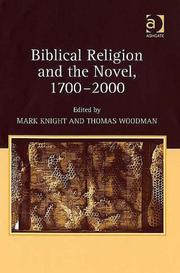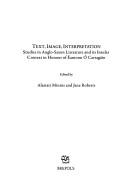| Listing 1 - 6 of 6 |
Sort by
|
Book
Year: 1997 Publisher: Cambridge New York Melbourne Cambridge University Press
Abstract | Keywords | Export | Availability | Bookmark
 Loading...
Loading...Choose an application
- Reference Manager
- EndNote
- RefWorks (Direct export to RefWorks)
Book
ISBN: 0691065020 9780691065021 Year: 1982 Publisher: Princeton, N.J.
Abstract | Keywords | Export | Availability | Bookmark
 Loading...
Loading...Choose an application
- Reference Manager
- EndNote
- RefWorks (Direct export to RefWorks)
English literature --- Thematology --- anno 1500-1599 --- Christianity and literature --- Religion and literature --- Protestantism and literature --- Reformation --- History and criticism --- Protestant authors --- History --- Tudor, House of --- English literature - Early modern, 1500-1700 - History and criticism --- English literature - Protestant authors - History and criticism --- Christianity and literature - England - History - 16th century --- Religion and literature - England - History - 16th century --- Protestantism and literature - History - 16th century --- Reformation - England
Book
ISBN: 9780415656849 0415656842 9780203077542 0203077547 1283972689 1135132321 9781135132323 9781135132279 9781135132316 9781138118591 1138118591 1135132313 Year: 2017 Volume: 21 Publisher: New York: Routledge,
Abstract | Keywords | Export | Availability | Bookmark
 Loading...
Loading...Choose an application
- Reference Manager
- EndNote
- RefWorks (Direct export to RefWorks)
This book visits the fact that, in the pre-modern world, saints and lords served structurally similar roles, acting as patrons to those beneath them on the spiritual or social ladder with the word "patron" used to designate both types of elite sponsor. Chapman argues that this elision of patron saints and patron lords remained a distinctive feature of the early modern English imagination and that it is central to some of the key works of literature in the period. Writers like Jonson, Shakespeare, Spenser, Drayton, Donne and, Milton all use medieval patron saints in order to represent and to challenge early modern ideas of patronage -- not just patronage in the narrow sense of the immediate economic relations obtaining between client and sponsor, but also patronage as a society-wide system of obligation and reward that itself crystallized a whole culture’s assumptions about order and degree. The works studied in this book -- ranging from Shakespeare’s 2 Henry VI, written early in the 1590s, to Milton’s Masque Performed at Ludlow Castle, written in 1634 -- are patronage works, either aimed at a specific patron or showing a keen awareness of the larger patronage system. This volume challenges the idea that the early modern world had shrugged off its own medieval past, instead arguing that Protestant writers in the period were actively using the medieval Catholic ideal of the saint as a means to represent contemporary systems of hierarchy and dependence. Saints had been the ideal -- and idealized -- patrons of the medieval world and remained so for early modern English recusants. As a result, their legends and iconographies provided early modern Protestant authors with the perfect tool for thinking about the urgent and complex question of who owed allegiance to whom in a rapidly changing world.
English literature --- Authors and patrons --- Christian patron saints. --- Saints in literature. --- Religion and literature --- Literary patrons --- Littérature anglaise --- Ecrivains et mécènes --- Saints patrons chrétiens --- Saints dans la littérature --- Religion et littérature --- Mécènes de la littérature --- History and criticism. --- History --- Histoire et critique --- Histoire --- Littérature anglaise --- Ecrivains et mécènes --- Saints patrons chrétiens --- Saints dans la littérature --- Religion et littérature --- Mécènes de la littérature --- Christian patron saints --- Saints in literature --- History and criticism --- English literature - Early modern, 1500-1700 - History and criticism --- Authors and patrons - England - History - 16th century --- Authors and patrons - England - History - 17th century --- Religion and literature - England - History - 16th century --- Religion and literature - England - History - 17th century --- Literary patrons - Great Britain --- Patrons

ISBN: 0754651177 9780754651178 Year: 2006 Publisher: Aldershot Ashgate
Abstract | Keywords | Export | Availability | Bookmark
 Loading...
Loading...Choose an application
- Reference Manager
- EndNote
- RefWorks (Direct export to RefWorks)
English fiction --- American fiction --- Bible and literature. --- Religion and literature --- History and criticism --- History --- Bible --- In literature --- -Bible --- -Bible and literature. --- -Religion and literature --- -82-97 --- Literature --- Literature and religion --- Literature and the Bible --- American literature --- English literature --- History and criticism. --- In literature. --- Religieuze literatuur --- Moral and religious aspects --- 82-97 Religieuze literatuur --- Bible and literature --- 82-97 --- Biblia --- English fiction - History and criticism --- American fiction - History and criticism --- Religion and literature - England - History --- Religion and literature - United States - History
Book
ISBN: 9781442645639 1442645636 9781442628496 1442628499 Year: 2014 Publisher: Toronto University of Toronto Press
Abstract | Keywords | Export | Availability | Bookmark
 Loading...
Loading...Choose an application
- Reference Manager
- EndNote
- RefWorks (Direct export to RefWorks)
"Relics and Writing in Late Medieval England uncovers a wide-ranging medieval discourse that had an expansive influence on English literary traditions. Drawing from Latin and vernacular hagiography, miracle stories, relic lists, and architectural history, this study demonstrates that, as the shrines of England's major saints underwent dramatic changes from c. 1100 to c. 1538, relic discourse became important not only in constructing the meaning of objects that were often hidden, but also for canonical authors like Chaucer and Malory in exploring the function of metaphor and of dissembling language. Robyn Malo argues that relic discourse was employed in order to critique mainstream religious practice, explore the consequences of rhetorical dissimulation, and consider the effect on the socially disadvantaged of lavish expenditure on shrines. The work thus uses the literary study of relics to address issues of clerical and lay cultures, orthodoxy and heterodoxy, and writing and reform."--Dust jacket.
English literature --- Religion and literature --- Relics --- Littérature anglaise --- Religion et littérature --- Reliques --- History and criticism --- History --- Histoire et critique --- Histoire --- Relics in literature --- Littérature anglaise --- Religion et littérature --- Relics in literature. --- 264-052 --- 27 <420> "04/14" --- Literature and religion --- Verering van relikwieën --- Kerkgeschiedenis--Engeland--Middeleeuwen --- Moral and religious aspects --- 264-052 Verering van relikwieën --- 248.159.7 --- Literature --- 248.159.7 Devotie tot de heiligen:--alfabetisch --- Devotie tot de heiligen:--alfabetisch --- History and criticism. --- History of the United Kingdom and Ireland --- Christian church history --- History of civilization --- anno 1200-1499 --- English literature - Middle English, 1100-1500 - History and criticism --- Religion and literature - England - History - To 1500 --- Angleterre --- Moyen Age

ISBN: 9782503518190 2503518192 9782503538679 Year: 2007 Volume: 18 Publisher: Turnhout: Brepols,
Abstract | Keywords | Export | Availability | Bookmark
 Loading...
Loading...Choose an application
- Reference Manager
- EndNote
- RefWorks (Direct export to RefWorks)
In emulation of Professor Éamonn Ó Carragáin, who has, over the last few decades, demonstrated how words and images together join in that extraordinary cultural achievement which is the Ruthwell Cross, the volume seeks to transcend the established methods of the single discipline.The twenty-six essays draw together insights from fields as diverse as archaeology, art history, and liturgy to reflect on the literature and material culture of the Anglo-Saxons. The first section looks outwards from the insular context, to medieval Rome, more generally to western Europe, and backwards to the world-geography of the ancient world; its illustrations include colour plates to illumine the hangings, clothing and vestments extant from Anglo-Saxon England. A range of texts is considered in the central section, Latin, English, and Old Norse. The third section focuses on sculpture, buildings and the insular landscape, juxtaposing the sculptured stonework of Northern Britain with early Christian monuments and remains from Ireland; among the illustrations are striking coloured photographs of Irish ecclesiastical sites. The contributors are from Canada, the United States, Italy, Britain, and Ireland.
091 =20 --- 09 <082 Ó CARRAGÁIN, ÉAMONN> --- 091 =20 Handschriftenkunde. Handschriftencatalogi--Engels --- Handschriftenkunde. Handschriftencatalogi--Engels --- Handschriften. Oude en merkwaardige drukken. Curiosa--Feestbundels. Festschriften--Ó CARRAGÁIN, ÉAMONN --- English literature --- Civilization, Anglo-Saxon --- Civilization, Anglo-Saxon in literature --- Civilization, Medieval --- Civilization, Medieval, in literature --- Christian art and symbolism --- Christian art and symbolism in literature --- Material culture --- Religion and literature --- Art and literature --- History and criticism --- History --- Ó Carragáin, Éamonn --- Angelsaksische beschaving --- Angelsaksische cultuur --- Anglo-Saxon civilization --- Beschaving [Angelsaksische ] --- Beschaving [Middeleeuwse ] --- Civilisation anglo-saxonne --- Civilisation médiévale --- Civilization [Anglo-Saxon ] --- Civilization [Medieval ] --- Civilization [Medieval ]--History --- Cultuur [Angelsaksische ] --- Europa--Beschaving--476-1492 --- Europe--Civilisation--476-1492 --- Europe--Civilization--476-1492 --- Medieval civilization --- Middeleeuwen--Beschaving --- Middeleeuwen--Cultuur --- Middeleeuwse beschaving --- Middeleeuwse cultuur --- Middle Ages--Civilization --- Moyen-Age--Civilisation --- Literature, Medieval --- Civilization, Anglo-Saxon. --- Sacred space --- Civilization, Medieval. --- Littérature anglaise --- Littérature médiévale --- Lieux sacrés --- Civilisation médiévale --- Art et symbolisme chrétiens --- History and criticism. --- Histoire et critique --- Histoire --- Literature --- Literature and religion --- Culture --- Folklore --- Technology --- Middle Ages --- Civilization --- Chivalry --- Renaissance --- Anglo-Saxons --- Art, Christian --- Art, Ecclesiastical --- Arts in the church --- Christian symbolism --- Ecclesiastical art --- Symbolism and Christian art --- Religious art --- Symbolism --- Church decoration and ornament --- Literature and art --- Literature and painting --- Literature and sculpture --- Painting and literature --- Sculpture and literature --- Aesthetics --- Moral and religious aspects --- Ó Carragáin, Éamonn. --- Ó Carragáin, É. --- Old English, ca. 450-1100 --- Literature [Medieval ] --- To 1500 --- Medieval, 500-1500 --- Middle Ages, 500-1500 --- Symbolism in art --- History. --- English literature - Old English, ca. 450-1100 - History and criticism --- Christian art and symbolism - England - Medieval, 500-1500 --- Material culture - England - History - To 1500 --- Religion and literature - England - History - To 1500 --- Art and literature - England - History - To 1500 --- Civilization, Anglo-Saxon, in literature
| Listing 1 - 6 of 6 |
Sort by
|

 Search
Search Feedback
Feedback About UniCat
About UniCat  Help
Help News
News